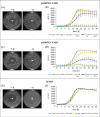Genetic modules for α-factor pheromone controlled growth regulation of Saccharomyces cerevisiae
- PMID: 39113811
- PMCID: PMC11300815
- DOI: 10.1002/elsc.202300235
Genetic modules for α-factor pheromone controlled growth regulation of Saccharomyces cerevisiae
Abstract
Saccharomyces cerevisiae is a commonly used microorganism in the biotechnological industry. For the industrial heterologous production of compounds, it is of great advantage to work with growth-controllable yeast strains. In our work, we utilized the natural pheromone system of S. cerevisiae and generated a set of different strains possessing an α-pheromone controllable growth behavior. Naturally, the α-factor pheromone is involved in communication between haploid S. cerevisiae cells. Perception of the pheromone initiates several cellular changes, enabling the cells to prepare for an upcoming mating event. We exploited this natural pheromone response system and developed two different plasmid-based modules, in which the target genes, MET15 and FAR1, are under control of the α-factor sensitive FIG1 promoter for a controlled expression in S. cerevisiae. Whereas expression of MET15 led to a growth induction, FAR1 expression inhibited growth. The utilization of low copy number or high copy number plasmids for target gene expression and different concentrations of α-factor allow a finely adjustable control of yeast growth rate.
Keywords: Saccharomyces cerevisiae; growth regulation; pheromone response; synthetic biology; α‐factor.
© 2024 The Author(s). Engineering in Life Sciences published by Wiley‐VCH GmbH.
Conflict of interest statement
The authors have declared no conflicts of interest. The manuscript does not include animal experiments or human studies.
Figures




Similar articles
-
A yeast pheromone-based inter-species communication system.Appl Microbiol Biotechnol. 2015 Feb;99(3):1299-308. doi: 10.1007/s00253-014-6133-5. Epub 2014 Oct 21. Appl Microbiol Biotechnol. 2015. PMID: 25331280
-
Application of the yeast pheromone system for controlled cell-cell communication and signal amplification.Lett Appl Microbiol. 2011 May;52(5):521-6. doi: 10.1111/j.1472-765X.2011.03035.x. Epub 2011 Mar 18. Lett Appl Microbiol. 2011. PMID: 21338378
-
Pheromones and pheromone receptors are the primary determinants of mating specificity in the yeast Saccharomyces cerevisiae.Genetics. 1989 Mar;121(3):463-76. doi: 10.1093/genetics/121.3.463. Genetics. 1989. PMID: 2653961 Free PMC article.
-
Functional characterization of an alpha-factor-like Sordaria macrospora peptide pheromone and analysis of its interaction with its cognate receptor in Saccharomyces cerevisiae.Eukaryot Cell. 2005 Apr;4(4):661-72. doi: 10.1128/EC.4.4.661-672.2005. Eukaryot Cell. 2005. PMID: 15821126 Free PMC article.
-
The pheromone signal pathway in Saccharomyces cerevisiae.Antonie Van Leeuwenhoek. 1992 Aug;62(1-2):95-108. doi: 10.1007/BF00584465. Antonie Van Leeuwenhoek. 1992. PMID: 1444339 Review.
References
-
- Nielsen J. Yeast systems biology: model organism and cell factory. Biotechnol J. 2019;14:e1800421. - PubMed
-
- Morata A, Loira I, Yeast Industrial Applications, InTech; 2017.
-
- Machida K, Tanaka T, Yano Y, Otani S, Taniguchi M. Farnesol‐induced growth inhibition in Saccharomyces cerevisiae by a cell cycle mechanism. Microbiology. 1999;145:293‐299. - PubMed
LinkOut - more resources
Full Text Sources
